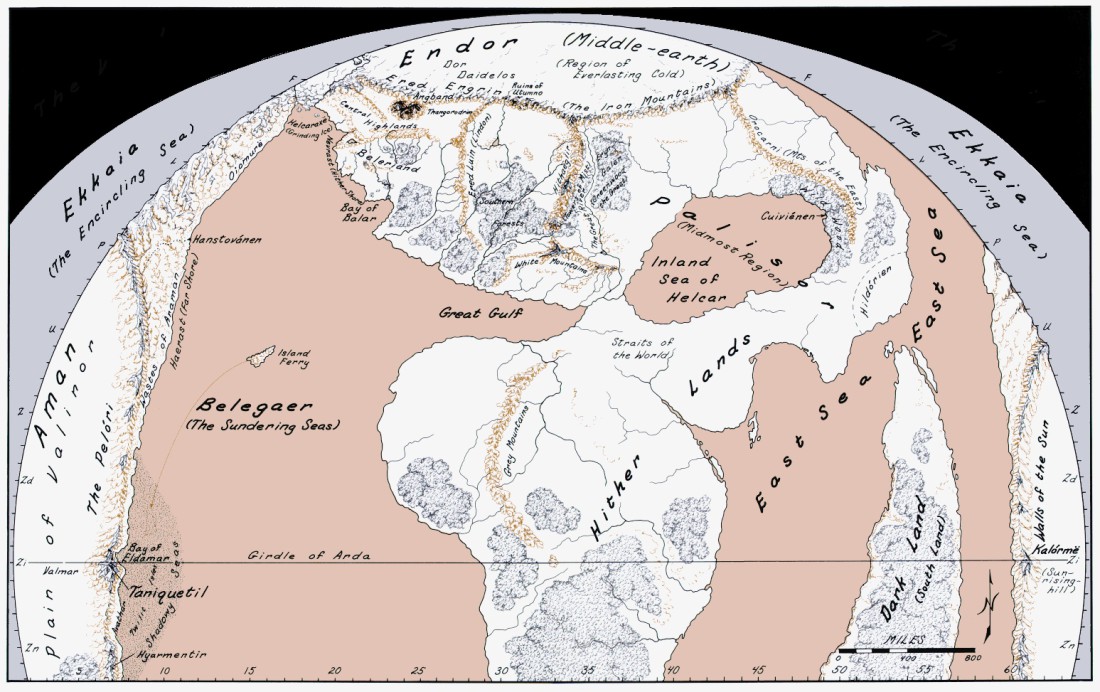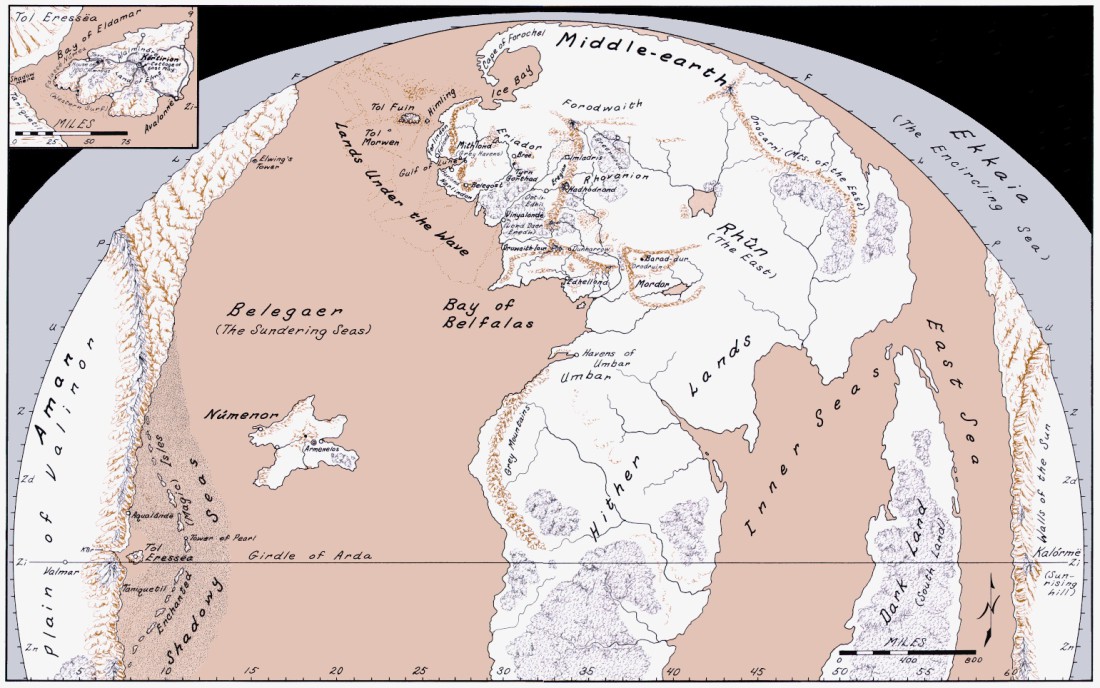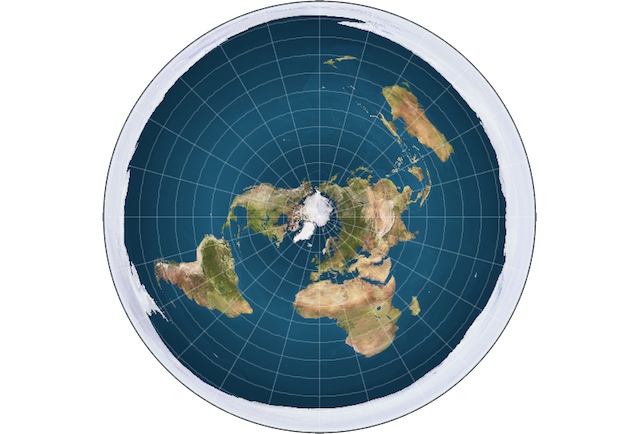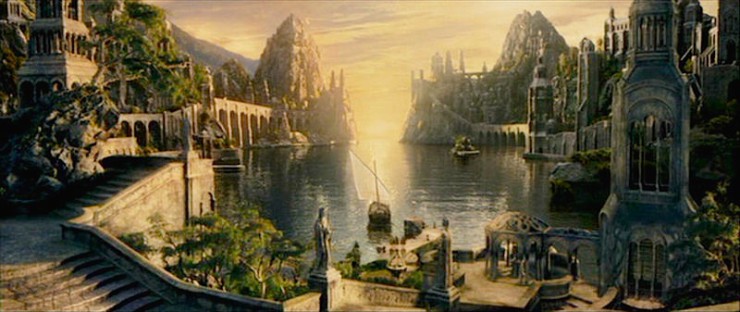Those who believe the Earth is flat may truly desire to live in a fantasy world.
In late January of this year, rapper B.o.B. took to Twitter seriously wanting to know why everyone thought the Earth was a sphere. Neil deGrasse Tyson, designated king of space, let B.o.B. know several ways that he could observe the Earth’s curvature for himself. For a man who can sometimes be a little overzealous in trying to apply science to character-based fantasy narratives, Neil took it pretty easy on B.o.B. Perhaps he knew that B.o.B. willingly dropped out of high school in the ninth grade, and probably missed the basic education in science that would have given the rapper the deductive tools needed to understand the mechanics of his world.
Neil probably also knows that one of our most beloved sagas, J.R.R. Tolkien’s The Lord of the Rings, begins on a flat [Middle-]earth, and that there is considerable mystique in the idea of a flat planet.
Even after B.o.B. released a meandering diss track, Neil kept it cute with a mic drop response on Larry Wilmore’s Nightly Show. The diss track is gone now and the matter seems(?) to be closed, with Neil and common sense prevailing. And yet, the members of the Flat Earth Society maintain their membership in the Flat Earth Society. There is clearly a strong allure to the idea of a disc-shaped planet.
Tolkien must have thought so, too, as his creation mythology of Middle-earth begins with the planet as a flat circle. This physical realm was known as Arda*, and well before the time of hobbits and rings, it was “sung” into being by the Ainur, the first creations of Eru Ilúvatar, the Creator of all things. Some Ainur showed interest in having a caretaking role over the newly created Arda and its denizens, including Elves and Men. These Ainur took physical form and dwelled on the flat planet, becoming Valar and their counterparts of lesser power, Maiar. To put this in perspective, the people that we know of as Gandalf, Saruman, and Sauron are all Maiar. And as we see in The Lord of the Rings, even a “lesser-powered” Maia like Sauron is still strong enough to warp Arda and bring about the near-extinction of entire species of beings.
*The definition of Arda changes as the structure of Tolkien’s cosmology changes and can also refer to the cosmos that the planet exists within. For the purposes of this article, Arda refers to only the planet itself.
Sauron didn’t generate his dark arrogance all by himself. He had a teacher in the form of Melkor (also known as Morgoth), one of the Valar who, during the creation of Arda, sang a counter-harmony to the chorus of creation that his Ainur brethren were fashioning. Because of this, chaos and entropy were sewn into the reality of Arda, and Melkor became so enamored with the chaotic physical realm of Arda that he came to live within it and eventually proclaimed that it belonged entirely to him.
In summary, Melkor/Morgoth is basically that guy in the car who insists on singing his own lyrics to “Bohemian Rhapsody.” And Sauron is enamored with him.
The Arda that Melkor initially claimed was a pretty boring place: a flat circle of land with a round sea in the middle and an island in the middle of that, much like an eye. Surrounding this flat circle of land was an Encircling Sea, which was itself surrounded by the Void.
Arda did not stay this way. The battles between Melkor and the rest of the Valar were numerous and repetitive. Melkor would mar the land, raising mountains or creating gaps that the Encircling Sea would rush into, before he was overpowered and banished into the Void. Then he’d find his way back and continue his process of alteration before being turned away again. Over time, these struggles produced a flat Arda with several continents on it, as imaged in The Atlas of Middle-earth by Karen Wynn Fonstadd.

Melkor and his servants took strongholds in the northern continent—the one we know as the Middle-earth that Tolkien’s main series takes place upon—while the forces of the Valar held the western continent of Valinor, which would later come to be known as The Undying Lands. Melkor (really, Morgoth at this point) held the central continent for the entirety of the First Age of Arda, a span of almost 600 years, before he and his servants were finally crushed by the Valar, and the First Age of the world was drawn to a close.
Even in defeat, Morgoth’s purpose remained fulfilled, for he marred the land so greatly that the Valar spent the dawn of the Second Age changing the landscape even further in order to correct this marring. The northern and southern continents were further merged, Mordor was formed, and an island known as Númenor arose from the Sundering Seas.

With Morgoth gone, his devotee Sauron rose to prominence and began his long bid for power, taking lands, swaying men, and forging some very familiar rings within the span of about 1500 years. In fact, Sauron’s hold on Middle-earth is maintained until the year 3446 in the Second Age, when Isildur defeats Sauron and has that awesome shouting match with his best bud Elrond.

In Tolkien’s legendarium, the entire history of Arda leading nearly up to the events that inspire the War of the Ring has taken place on a completely flat planet surrounded by a sea, ringed by a void. This kind of setting is certainly atmospheric, and helps to deliver an epic scope to the history leading up to The Lord of the Rings. On a flat, enclosed disc of a world, wars between demigods like Melkor, Sauron, and the Valar truly determine the fate of all.
This kind of setting, one that makes the world knowable and inescapable, seems to appeal to those believe in a flat Earth, as well. Ashley Feinberg at Gawker summed up the various workarounds that Flat Earthers use to explain everyday phenomena, and the list reads similar to considerations Tolkien made when constructing the beginning of Arda and Middle-earth.
Flat Earthers postulate: The firmament, a solid dome sky with the Sun, Moon, and stars embedded within it.
Tolkien postulates: The void, an open space around Arda where the Sun, Moon, and stars move on their daily trajectories above and below the flat disc of the planet.
Flat Earthers postulate: The ice wall, a pitch black, absolute zero barrier that surrounds the disc of our flat Earth and which can’t be voyaged beyond.
Tolkien postulates: The Encircling Sea, which can be voyaged upon and passed through, although if you’re of the race of Men, that will hastily result in your death.

Flat Earthers postulate: A vast conspiracy between world governments (who always famously get along) and NASA to falsify evidence of a round planet for… reasons?
Tolkien postulates: An unimaginative God-being that keeps getting its nice flat featureless planet messed up by its children, one of whom is literally just trying to make his own stamp upon the world.
Flat Earthers postulate: Universal Acceleration instead of gravity. Basically, that our flat planet is flying through a plasma-like medium called “aether” face-first, pressing all of us down onto the surface of the Earth. Why this is necessary is unclear, since a flat planet with a domed underside would still be plenty massive enough to keep us grounded via gravity.
Tolkien postulates: No flying creatures. Except eagles, friendly thrushes, dragons, black arrows, fellbeasts, that one moth Gandalf keeps whispering at, and Gimli when being tossed. Okay, so lots of flying creatures, but also gravity. Because Arda does have a domed underside, called “Ambar.” Presumably, Tolkien including this in his cosmology presented no problems.
The parallels between Tolkien’s world-building and Flat Earth beliefs can be very direct when listed out by feature. To those who believe in a Flat Earth, these parallels may simply be further confirmation that our real world is capable of existing as a disc instead of a sphere. Tolkien’s world certainly feels real to its readers, after all, and the author was exhaustive in detailing its history, its composition, its language, and even its future. Perhaps Tolkien was a Flat Earther himself, and was simply seeding in the truth of things through his epic tale…
Except that even Middle-earth eventually became round. Around one hundred years before Isildur battled Sauron, the dark lord wheedled his way into power on the island of Númenor, stationed halfway between the Valar’s Undying Lands and Middle-earth. For one Vala in particular, this was the last straw. Manwë, brother of Melkor, asked the Creator itself, Eru Iluvatar, to make an example of those who would ally themselves to Sauron. The Creator obliged, sinking Númenor, making the flat Arda into a sphere, and severing the continents of the Valar’s Undying Lands from Arda. A man (or woman, or elf) could leave from the Grey Havens in the west and sail all the way around the globe, eventually hitting the lands east of Mordor.
With The Undying Lands inaccessible, Middle-earth was now alone on the planet of Arda. The new spherical world stood as both a warning and a gift: do not let dark prophets misguide you. For if you succeed in casting off their sway, then the Fourth Age, the Age of Men, will ensue and this world will be yours to sculpt.
In crafting his fictional world, Tolkien gets to the very heart of why Flat Earth beliefs feel so offensive. It isn’t just the ignorance that these beliefs champion, or the refusal of the gift of knowledge that previous generations grant to us, but the limitations that beliefs like this impose upon others. By being so dedicated to the fantasy of a Flat Earth, a believer is insisting that the expression and ingenuity of mankind is limited to two dimensions, that the horizon is impassable, that we are stuck in our ways.
This is a hopeless way to see the world. And perhaps this is one of the reasons why we construct such elaborate fantasies through art and literature, not to close off possibilities within our own lives, but to illuminate the straight way out of such hopelessness.
Chris Lough writes about fantasy and superheroes and things for Tor.com. Over time he has also gone from flat to spherical.











Small nitpick: ‘Valar’ and ‘Maiar’ are plural. Gandalf is a Maia, Varda is a Vala.
the main difference, though, is tolkien was crafting a mythology. arda is round…why? oh, here’s what happened…now, sure, in LoTR, we’ve got people who lived through those events, but even so, all of tolkien’s works are, in my mind, to be read as myths.
what really stumps me though, is why the hell did you not use the discworld for this article? too obvious?
Thanks Irina, I’ve fixed those instances.
Short answer, twiff, is that Discworld was indeed too obvious. Long answer is that the parallels between Tolkien’s mythology and the Flat Earth conspiracy are clearer, which allowed me to dig into the reasoning behind the personal appeal of flat Earths. Tolkien’s mythology is so rich and well-built that it allows for a lot of fun subjective interpretation, whereas Discworld kind of does the subjective interpretation for you.
Interestingly, later in Tolkien’s life, as he was revising the Silmarillion he seriously considered rewriting the whole thing to be ‘astronomically’ correct, although it pained him to lose such elements as Fingolfin marching during the first moon rise, etc. I think he generally wanted the version we hear to be mannish versions of the actual Elvish myths, but the Elves knew ‘the truth’ about the world. Honestly, this made me a little sad as I wanted the stories to be true at least in his version of the universe! But the History of Middle Earth series (especially the later volumes) go into a ton of detail on this.
But at any rate – no. Tolkien was not a Flat Earther.
The flat-to-round earth means that when Frodo and everybody went to the undying lands, they traveled through outer space.
I hate to be one of those fans, but I can’t help myself:
Uhmm..No. The whole point of “Arda marred” was that it could not be “fixed” or undone. It was more than a physical reformation of the landscape; Morgoth had distributed his being throughout the substance of Arda, thus leading to corruption, decay and such. I’m not sure where you get that the Valar spend the early part of the Second Age ‘repairing’ Arda and forming Mordor, as that is not in any source I’ve read. Numenor was raised as a gift (it was called the Land of the Gift) for the houses of the Edain that suffered so much at the hands of Morgoth and remained true to the end. It was not part of any ‘Fix Middle-earth’ program.
This is not entirely true, as the Elven Kingdoms in Middle-earth resisted him, and with the assistance of Numenor manged to, barely, hold him off until the last king of Numenor gathered a force so mighty and powerful that Sauron’s forces deserted him and he (Sauron) was taken as a hostage back to Numenor.
Again, not quite true, as while in Numenor, Sauron corrupted (or further corrupted, they had already fallen far) the king and most of his people such that they completely rebelled against the Valar and tried to assail Valanor itself in the misguide hope that this would allow them to claim immortality. The Valar responded by turning their guardianship over to Eru, the One (basically God), who changed the shape of the world and buried the offenders in the earth and destroyed Numenor. This removed Valinor from the circles of the world and it could no longer be reached by normal means as all the seas where ‘bent’ (i.e. the world was now a globe.) Thus when elves take ship to Valinor, they take the ‘straight’ road’; they do not follow the curvature of the earth but rather go directly to Valinor in a line.
So the establishment of the Realms in Exile (Gondor and Arnor) by the remnant of the ‘faithful’ Numenorians (Elendil and his sons), Sauron’s return to Mordor and entirety of the Last Alliance and the following ages take place in spherical world.
Edit: spelling corrections, thank you for catching it Chappers
@6 – I love when people are ‘that fan’. haha :)
Lisamarie@@.-@ Have you a source for that? Sounds just like Tolkien (no wonder he hardly got anything to publication…), but I don’t think I’ve heard that before.
gadget@6 Thank you, the world needs more people who care to, you know, actually get the details right, and you said more and better than I would have bothered with!
Leading to the famous quotation which explains the title of Volume X of The History of Middle-Earth:
(There’s something profoundly unsettling about that description… then again, better that than wherever Ungoliant crawled from.)
And one very minor correction: straight road.
@8 – it’s basically the entire last chunk of the HOME series that focuses on this, but especially the essay ‘Myths Transformed’ in volume 10 (Morgoth’s Ring).
Which, coincidentally, is referenced by your quote ;)
Universal Acceleration instead of gravity. Basically, that our flat planet is flying through a plasma-like medium called “aether” face-first, pressing all of us down onto the surface of the Earth. Why this is necessary is unclear, since a flat planet with a domed underside would still be plenty massive enough to keep us grounded via gravity.
I suspect because if you were on a flat planet with a domed underside – cut a sphere in half and stand on the flat side, basically – the force of gravity wouldn’t be at right angles to the surface. It would be towards the centre of mass. So if you were standing in the centre of the circle, gravity would be at right angles and you’d feel like you were standing on a flat level plane; but further out, you’d feel gravity at an angle to the surface, and you’d have the impression of standing inside a vast bowl. Right out at the edge the force of gravity would be closer to parallel to the surface and it would be like climbing up a steeply sloping cliff.
The only way to have gravity and feel like the world is flat is, ironically, to have a round world.
@9 Ah, thanks. One day, I will both track down copies of HOME, and actually read them. One day…
@11 doooo it! One of the later ones has some unpublished epilogues to Lord of the Rings that made me a little teary :)
As in so many other questions regarding Tolkien’s legendarium, things are rather more complex …
In actual fact, The Lord of the Rings is written half under the flat-world-made-round conception, and half under the earth-created-as-a-globe conception.
Already c. 1946 – long before he finished the first draft of The Lord of the Rings – Tolkien wrote the first ‘Round-world version’ of his great cosmogony, Ainulindalë or The Music of the Ainur (version C*). This means that parts of The Lord of the Rings are written in a period where Tolkien wanted to change the early history of the Earth, so that it was created as a globe with a Sun and Moon from the first. For the attentive reader, there are traces of this in The Lord of the Rings itself, just as there are also traces of the earlier conception of flat-world-made-round. The history of Tolkien’s efforts, in two attempts, to change his legendarium from the flat-world version to a round-world version is documented in Morgoth’s Ring, partly in part 1 about the Ainulindalë and partly in part 5, ‘Myths Transformed’.
I discuss this (and other similar issues) here: http://parmarkenta.blogspot.com/2011/02/lord-of-rings-as-transitionary-work.html
Oh, and yet one more nitpick: Arda refers to either the solar system or to just the planet Earth itself, but never to the entirety of the universe – that is Eä. When the word was introduced, if memory serves at some point in the thirties, it referred to the Earth, the planet itself, but in later writings (the Athrabeth Finrod ah Andreth and in texts in ‘Myths Transformed’) Tolkien wanted to extend the meaning to the whole of the solar system.
I managed to make a mess of my link, sorry! It should be: http://parmarkenta.blogspot.dk/2011/02/lord-of-rings-as-transitionary-work.html
Awesome post, Troels!
Tolkien never used the word “sphere.” In fact all he mentions after the refashioning of Arda was that the Undying Lands were “separated” from mortal lands, and that all roads to them had become “bent.” That is all that is stated. The Flat Earth model for Arda remained til the end, since we cannot assume to know his emerging or changing view of the model…
R>
“since we cannot assume to know his emerging or changing view of the model…” – except for the fact that we can, based on his own writings later in life that describe ideas he never was able to completely re-incorporate into his work. If he actually had managed to publish the Silmarillion it would probably be quite a bit different from what Christopher Tolkien was able to put together (and even Chris Tolkien admits he probably made some mistakes).
“…except for the fact that we can, based on his own writings later in life that describe ideas he never was able to completely re-incorporate into his work.”
If what I’m hearing is correct, Tolkien originally drew up his world from a creationist worldview in an enclosed flat earth cosmology system and it was published as such, however, Tolkien’s later writings suggest a change in this view–nevertheless, the stories remain on a flat earth, with no maps showing any change in this dynamic including those from Karen Wynn Fonstad’s incredible “extra-biblical” Atlas, correct?
And Chris Lough, it would seem you are a no-nonsense guy when it comes to the headline of your article: “The Earth Isn’t Flat but Middle Earth is”. While you do a great job summarizing important events throughout the history of middle earth, you are not shy about showing your disdain for Tolkien’s choice in creating his setting as a flat earth world. But either way you look at it and whatever one’s stance might be on what is true about our world, at the end of the day one must be mythology.
“Arda” for Earth is Tolkien’s borrowing from Germanic “gard” (as in Midgard from the Thor Marvel comics) or Old English “geard” (as in middan-geard in the same poem by Cynewulf that Tolkien got Earendil from).
It’s cognate with Dutch Aard that young Tolkien may have picked up in South Africa from words like Aardvark, and with “garden” — that’s for Sam (also with “yard”).